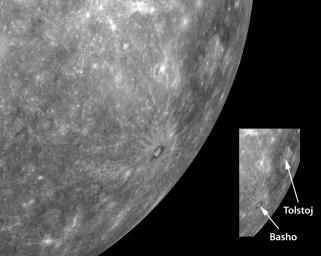
|
Looking Toward Mercury’s Horizon
- Click the image above for a larger view
- Full-Res JPEG (4321 x 3440) (1.2 MB)
- Full-Res TIFF (4321 x 3440) (14.9 MB)
Caption:
This striking high-resolution view of Mercury's horizon is a mosaic of multiple, individually acquired, MDIS images. Visible near the horizon are two named impact craters: Basho and Tolstoj. Basho can be distinguished as the crater just a little below the center of this image, with a distinctive collar of dark material and a set of bright rays that radiate outward from the crater. The bright rays indicate that Basho is relatively young. The dark material around Basho's rim may represent rocks with a different chemical composition that lie below Mercury's surface but were exposed by the impact event that created Basho. To the northeast of Basho is the much larger Tolstoj impact basin. Tolstoj can be seen in this image as a broad annulus of dark material enclosing an expanse of brighter terrain. Could it be that this dark material is similar to Basho's and was also excavated from below Mercury's surface when the Tolstoj-forming impact occurred? MESSENGER's orbital mission will provide a variety of data needed to investigate this question and many others aimed at understanding the composition of Mercury's crust and its variation both laterally and with depth.
Date Acquired:
January 14, 2008
Instrument:
Narrow Angle Camera (NAC) of the Mercury Dual Imaging System (MDIS)
Scale:
Basho is 80 kilometers (50 miles) in diameter. Tolstoj is 390 kilometers (240 miles) in diameter.
Background Info:
These images are from MESSENGER, a NASA Discovery mission to conduct the first orbital study of the innermost planet, Mercury. For information regarding the use of images, see the MESSENGER image use policy .
Cataloging Keywords:
| Name | Value | Additional Values |
|---|---|---|
| Target | Mercury | |
| System | ||
| Target Type | Planet | |
| Mission | MESSENGER | |
| Instrument Host | MESSENGER | |
| Host Type | Orbiter | |
| Instrument | Mercury Dual Imaging System (MDIS) | |
| Detector | Narrow Angle Camera (NAC) | |
| Extra Keywords | Crater, Grayscale, Impact | |
| Acquisition Date | ||
| Release Date | 2010-10-26 | |
| Date in Caption | 2008-01-14 | |
| Image Credit | NASA/Johns Hopkins University Applied Physics Laboratory/Carnegie Institution of Washington | |
| Source | photojournal.jpl.nasa.gov/catalog/PIA13674 | |
| Identifier | PIA13674 | |
